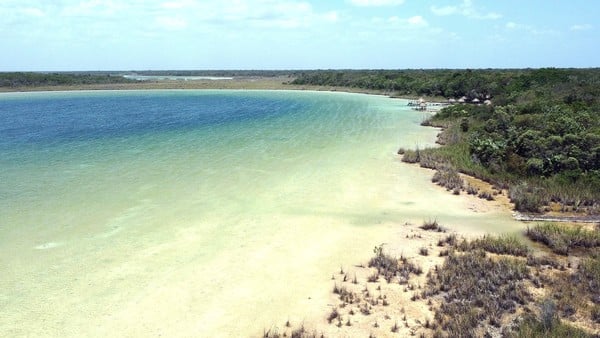Global Courant 2023-05-18 15:16:16
The area seeks to attract tourism focused on culture, nature and history.
A Mayan area with seven lagoons in the Mexican Caribbean seeks to attract tourism focused on the culture, nature and history of this native people, said Daniel Andrés Reyes Pat and Zendy Euan Chan, community guides from the Mayakaan area.
During a tour of the Ocom Lagoon System, which consists of seven lagoons in the Much Kanan Ka’ax (Together We Care for the Forest) community reserve, they showed how peasants in the region care for 1,235 hectares and promote ecotourism developments to maintain it.
The first of these lagoons is a few meters from the federal highway that connects Cancun with the capital of Quintana Roo, Chetumal.
This area is just over an hour from Tulum, in the Riviera Maya, and in front of the protection zone of the Sian Ka’an Biosphere Reserve.
Tourists enjoy a lagoon in the Much Kanan Ka’ax reserve, in the municipality of Felipe Carrillo Puerto. Photo EFE/Alonso Cupul
“This is what the Felipe Carrillo Puerto ejido (community field) is, this one here is the Sian Ka’an Biosphere Reserve. They adjoin the Sian Ka’an Biosphere Reserve and other common lands”, explains Zendy Euan.
In addition to being a guide, Daniel Andrés Reyes Pat is in charge of Síijil Noh Há, a local spa run by a group of community members.
“I am in charge of Síijil, we are at the Síijil Noh Há Ecotourism Center, we are in the place of the cenote,” he says.
This Mayan area with seven lagoons seeks to attract tourism focused on culture, nature and history. Photo EFE/Alonso Cupul
Ecological and non-mass tourism
Síijil Noh Há has six cabins for two people and a large one where up to 12 people can stay, supplied with electricity through solar cells; It also has a camping area.
Many of the restaurant’s food ingredients come from nearby orchards.
“Among the seven lagoons, we are in the one that belongs to the ejido of Felipe Carrillo Puerto, it is an area destined for non-mass tourism,” adds Reyes Pat.
In the area there are accommodations with solar energy and orchards that supply restaurants. Photo EFE/Alonso Cupul
In the ecotourism center they handle reservations directly and do not work with large tourism agencies.
The reason, as they explain, is that many impose their conditions and exclusive contracts that would not allow them to maintain their uses and customs, a situation that is repeated in community projects in the area.
“Reservations are made directly at the ejidal office, we give them a phone number or on the official Facebook page, which is SiijilNohHa, or by email and at the phones that are on the page,” he details.
Tourists who come to the area are mainly European. Photo EFE/Alonso Cupul
Zendy Euan explains that many of the tourists who arrive are mainly European, and unlike mass tourism in Cancun or the Riviera Maya, they prefer more natural attractions without being obsessed by the lack of connectivity, since in much of the area there is no telephone or internet .
Like other projects in the area, they promote the arrival of small groups and seek to get away from mass tourism.
Some of the activities they carry out are kayaking, biking, interpretive hiking and bird monitoring.
Lourdes Cruz / EFE








